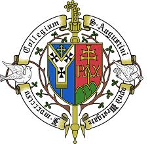with kind permission of James Brazier, Editor, The Pugin Society
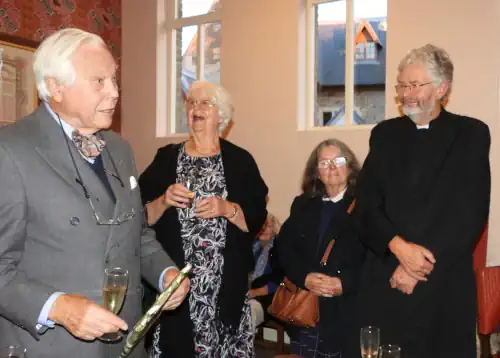
James Joll (left) in Ramsgate for the Pugin Society event on 11th September. Next to him is Sarah Houle, President of the Society and a direct descendant of Pugin, and beside her are Anne Heans and her husband Fr. Simon Heans, Chaplain of St Augustine's Shrine church, Ramsgate. James Joll is holding a package containing a recently-discovered original letter written by Augustus Pugin which was presented to James by Catriona Blaker on behalf of the Pugin Society. A full report on the event is contained below.
A JOYOUS EVENT IN RAMSGATE
At 5pm on Wednesday, 11th September, it was splendid to see such a full house in Pugin’s own church of St Augustine’s, all assembled for a very special event. Titled ‘Thirty Years On; celebrating the 1994 exhibition at the V&A Pugin: a Gothic Passion’, this was a talk and PowerPoint presentation by the exhibition curator Paul Atterbury, who was joined in discussion by Rosemary Hill, author of the definitive biography of Pugin, God’s Architect. These are two people who in different ways have immeasurably advanced the course of Pugin studies. Society members and many others were present to hear Paul give a fluent and fascinating account into the thinking behind the making of the 1994 exhibition, its aims and its design. Then, in relaxed and accomplished fashion, there followed a dialogue between him and Rosemary Hill. Rosemary, who was researching God’s Architect at this time, was closely involved with the many discoveries and new material that came to light during the making of the exhibition. This was indeed a stimulating time for Pugin scholars and others. The wide variety of those working on Pugin could be seen in the excellent publication Pugin: a Gothic Passion, a wonderful resource, which accompanied the exhibition.
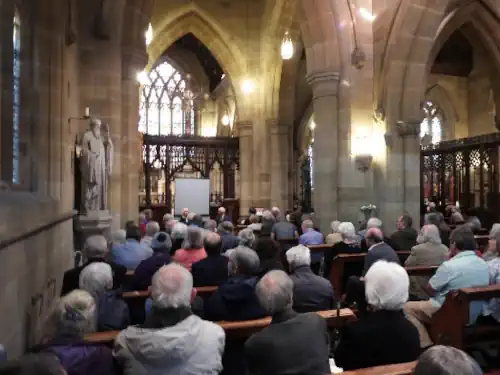
The session in the church was followed by a champagne reception in the Cartoon Room at The Grange, next door. It was gratifying and encouraging to see, both in the church and the Cartoon Room, the broad variety of people present – our Patron Sandra Wedgwood, our President and Pugin descendant Sarah Houle and husband David, Father Jonathon Routh of the parish of Ramsgate & Minster, representatives from the Ramsgate Society, journalists, up and coming William Burges scholar Katie Williams, Palace of Westminster photographer George Garbutt, and many other old and new friends. Also amongst those attending was director James Joll, whose firm, Pearson, was the sponsor of the V&A exhibition. James had also very generously funded our own Society event and was presented with a thank-you from the Society in the form of a newly- discovered Pugin letter, found on eBay. He is a great collector and Pugin enthusiast, and this will perhaps, in a small way, be something else to add to his treasures.
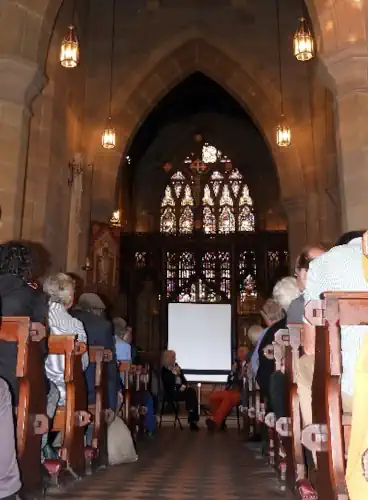
The Society is very fortunate that Paul Atterbury gave it his exhibition archive, and in the east cloister, prior to this event, a small display had been prepared using material from the archive and explaining, in simple terms, the significance of the exhibition.
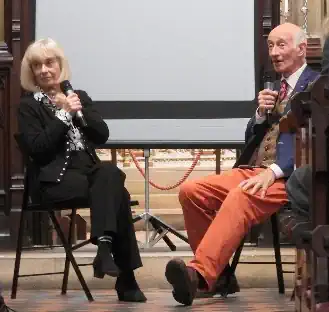
Photo: James Brazier
All we have to do now is to consider how the Society can, in a changing world, take interest in Pugin and his legacy forward, and build further on the ongoing influence of the 1994 exhibition and Rose- mary Hill’s great biography. No mean task, but - En Avant!
Catriona Blaker
Some photos of the reception held in the Cartoon Room ...
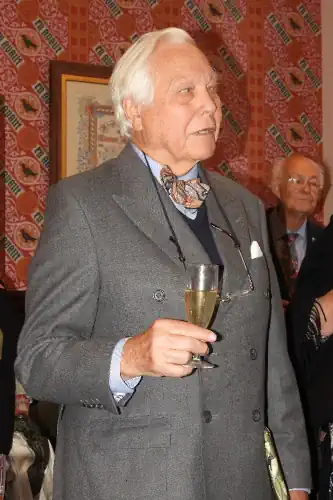
Photo: James Brazier
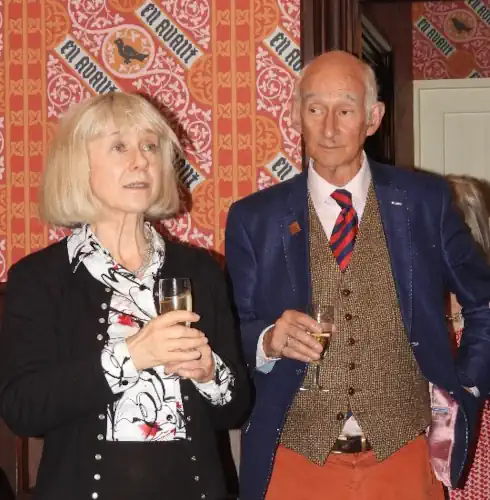
Photo: James Brazier
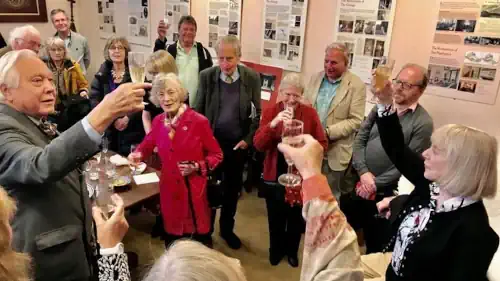
Photo: George Garbutt
An Unidentified Pugin Monstrance
It was in 1995, the year after the Pugin Exhibition at the V&A Museum, that my late partner, the Rev’d Anthony Couchman (b.1937; d.2022). was sent. typed catalogue of second-hand communion plate on offer from. firm of church furnishers in the north of England. In it was. monstrance, described as “sunburst type, gilt brass, complete with crescent lunette, the central roundel and the cresting cross set with garnets”. Without further ado, he telephoned the firm and purchased the item unseen.
On its arrival his hunch was confirmed, for it was, as he had suspected,. Pugin/Hardman creation of the 1840s. After professional cleaning, the research began. In short, the prototype of this particular sunburst monstrance was designed by. W. Pugin over the winter months of 1844-5 and made by John Hardman of Birmingham in 1846 for the Earl of Shrewsbury for St Giles’, Cheadle. According to the Hardman Archives in Birmingham, this “Richly gilt Monstrance, Sun Pattern. Engraved and set with Stones”, which cost £21 10s, was dispatched to Cheadle on 16th August 1846. The Earl of Shrewsbury subsequently gave. similar monstrance to St Chad’s Cathedral, Birmingham.
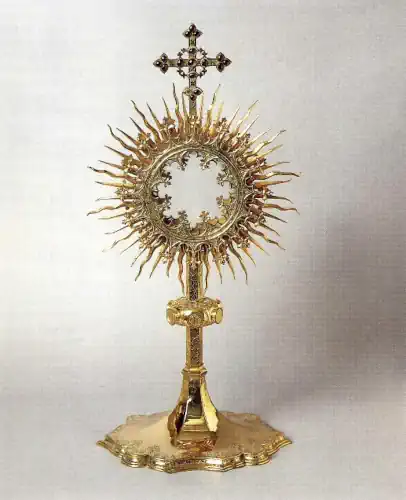
Between 1846 and 1847, Shrewsbury had paid Hardman £1,400 for various items of metalwork for Cheadle. To ensure that he got value for money, Shrewsbury generally insisted on plated base metal rather than precious metal. The electroplating process had been patented by. R. H Elkington. Co in 1837, the year in which Hardman entered into partnership with Elkingtons and with another Birmingham button-making firm, Hammond. Turner, for the specific purpose of working the Elkington electro-gilding process, though it did not produce such as hard-wearing. finish as the mercurial amalgam used in previous years. Be that as it may, it was used extensively by Hardman for Pugin during the 1840s, thus fulfilling Pugin’s view that “Any modern invention which conduces to comfort, cleanliness, or durability, should be adopted by the consistent architects.”
Unfortunately, precisely how many of these gilt brass monstrances were made has not been recorded. Standing. little over 19 inches in height and being. inches in width it is not as large as some of Pugin’s later monstrances. But cleaned up, and with one missing garnet replaced, Fr Anthony had to admit that it was. ‘snitch’ at £250. Thirty years on, one doubts if such bargains are to be had.
Dr Julian. S Litten FSA
July 2024
Dr Julian Litten FSA is a member of the Pugin Society and a former curator at the V&A Museum (1966-1999). As England's foremost funerary historian, it was he who recorded the Pugin Vault at Ramsgate on 29th October 1992.
An acquaintance who from an early age has been associated with St Mary’s Abbey at Colwich, near Stafford, has asked me if the Pugin Society knows of the whereabouts of. suitable redundant High Altar for the conventual chapel there.
Colwich Abbey has its origins in. convent in seventeenth century Cambrai in the Spanish Netherlands, which established. daughter house in Paris in 1652. This was suppressed in the French Revolution. After the release of the nuns, they moved to England and settled in Dorset, then in Somerset before moving to Colwich, where St Benedict’s Priory was formed by adapting an existing building. This had originated as. house built by Charles Cope Trubshaw in about 1767. In 1791, it was sold to Charles Selleck Brome and is referred to as ‘The Mount’ in. document of 1796. In 1828, the building was acquired by Robert Shirley, Viscount Tamworth (eldest son of the 8th Earl Ferrers) and converted into. shooting box. It was referred to in. document of 1829 as ‘Mount Pavilion’ and the style has been referred to variously as Tudor Gothic and early 19th century Gothick.
In 1835, the whole estate, including 50 acres of land, was purchased on the recommendation of Bishop Walsh, Vicar Apostolic of the Midland District (and who was to become. great supporter of Pugin), by Mother Mary Clare Knight of Jesus, Prioress of the Benedictine nuns then at Court House, Cannington, Somerset. The funds were provided by. novice, Sister Teresa Gertrude Tempest, who had brought. large fortune with her. Mother Mary Clare began additional building work and, in 1836, the nuns moved in. The house was named St Benedict’s Priory and, in 1837, building work continued, including. chapel which was formed by turning the entrance hall into the choir and. boudoir into the sanctuary.
According to Eaton (1929): 'Mother Mary Clare… now procured the services of the celebrated architect, Welby Pugin, who designed the three stained-glass windows over the altar. These were some of the first done in England by this great artist and have been much admired for the richness and depth of colouring. He also erected. Gothic reredos. These decorations were largely due to the generosity of Lord Clifford and of Mr Weld, of Lulworth…’ Pugin's involvement would seem to be confirmed by his diary for 19th August 1837 which includes the entry ‘Priory Stafford’.
In 1928, the community was raised to abbey status, when it was renamed St Mary’s Abbey. In 1929, the chapel was altered by the addition of an enlarged apsidal sanctuary and side chapels in matching materials to designs of architect. Arnold Crush (1844/5-1936) of Birmingham, who had been. pupil of Sir Giles Gilbert Scott and Sir Edwin Lutyens. As part of this work, Pugin’s windows were replaced by three two-light and tracery stained-glass windows, which appear to be the work of Geoffrey Webb (1879- 1954) of East Grinstead,. pupil of Kempe and Ninian Comper. The attribution has yet to be confirmed, but it seems highly likely given the fact that both Crush and Webb were involved later with the church at Douai Abbey in Berkshire.
Parts of Pugin’s three windows probably survive in the two-light and tracery window depicting Benedictine abbesses St Gertrude and St Walburga in the north wall of the north-flanking side chapel.. clue to their having been modified to fit is the atypical narrow plain border seen in the image below.
Although the ornamentation on the geometric background pattern is not visible, the overall pattern is similar to some other early Pugin windows. They are not recorded in the Hardman First Glass Day Book as they predate Pugin’s use of Hardmans for making windows, nor are they mentioned in Shepherd (2009. 2022).
As to Pugin’s reredos (possibly of wood), this could have been reused in the new sanctuary, or somewhere else in the chapel. Anyway, the High Altar was WANTED: Redundant High Altar for Colwich Abbey The Pugin Society e-newsletter Issue 29. Autumn 2024 The two-light and tracery window in Colwich Abbey depicting the Benedictine abbesses St Gertrude and St Walburga. 5 removed during the reordering of the sanctuary in the late 20th century.
Due to a decline in the number of occupying nuns, the Grade II Abbey was put up for sale in 2020. It is being purchased by. US-based traditional order of nuns, the Benedictines of Mary Queen of the Apostles, who wish to restore it to its former glory, including reinstating. High Altar to replace that removed when the sanctuary was reordered. Details may be found at: https://benedictinesofmary.org/about-us/colwich/.
Should any members of the Society know of a suitable High Altar, I am happy to be the point of contact for messages, and my email address is: nickbeveridge@hotmail.com
Nicholas Beveridge
Sources (publications) consulted:
* Eaton, Robert, The Benedictines of Colwich 1829-1929 (London: Sands & Co, 1929): 191-202
* Greenslade, Michael, Catholic Staffordshire 1500-1850 (Leominster: Gracewing, 2006): 208
* Shepherd, Stanley, The Stained Glass of A.W.N. Pugin (Reading: Spire Books Ltd, 2009; Seraphim
Press Ltd, 2022)
Sources (internet) consulted:
* Scott, Abbot Geoffrey: St Edmund’s Abbey, Woolhampton 1903-2003:
https://www.douaiabbey.org.uk/files/HistCHAP4b.pdf
* ‘Taking Stock’ entry: Colwich – St Mary’s Abbey:
https://taking-stock.org.uk/building/colwich-st-marys-abbey/
* Wikipedia entry for Geoffrey Fuller Webb:
https://en.wikipedia.org/wiki/List_of_works_by_Geoffrey_Webb
FUTURE EVENTS
Thursday, 10th October
The visit to the Victoria & Albert Museum, led by Dr Peter Lindfield, to see the newly acquired Pugin drawings, is now fully booked.
Saturday, 14th December
The Pugin Society Annual General Meeting, followed by a talk on William Burges by MA student Katie Williams and a festive tea at the Art Workers' Guild, 6 Queen Square, London, WC1N 3AT.
The exact time, the Minutes of last year’s AGM and further details to be circulated nearer the date.
The original PDF file can be viewed here.
with kind permission of James Brazier, Editor, The Pugin Society
